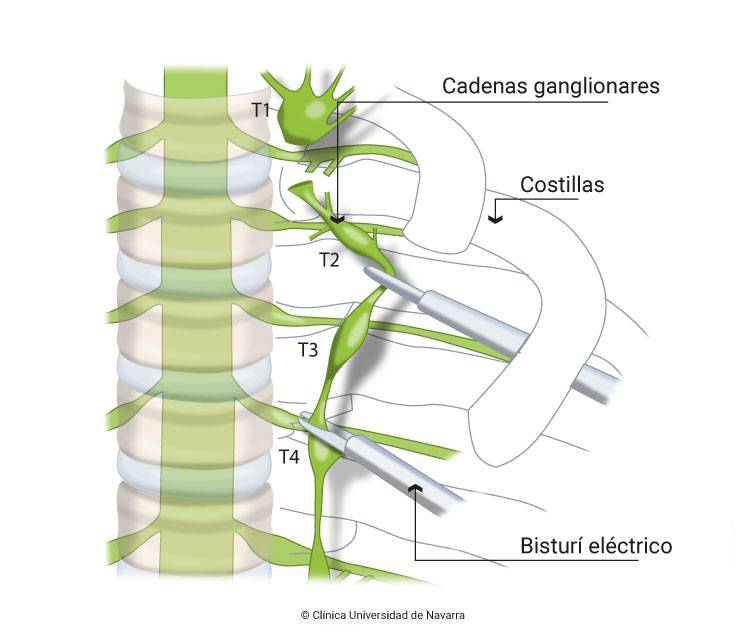Endoscopic Thoracic Sympathectomy
"Minimally invasive surgery allows us to perform operations that are much less aggressive for the patient, with faster recovery, fewer complications and greater safety".
DR. MARÍA RODRÍGUEZ CODIRECTOR. THORACIC SURGERY DEPARTMENT

Palmo-axillary hyperhidrosis or pathological sweating of the palms and armpits has received many different treatments over the last hundred years.
However, these conservative medical treatments can rarely control the problem in a really effective and continuous way, something that people who suffer from this pathology know very well.
The surgical treatment consists of selective upper thoracic sympathectomy, that is, the destruction of the sympathetic nodes that control the sweating of the hands.
It is performed by endoscopy, which has made it possible to reduce surgical aggressiveness and facilitate treatment.
Today it is applicable to the most serious cases (one in four affected) and the results are highly satisfactory because of the definitive nature of the treatment.

When is surgery for hyperhidrosis indicated?
Surgical treatment is indicated in patients who present hypersudoration of the palms, either alone or together with the armpits, feet and/or face.
We will only carry it out when the medical treatment has failed or has had little result in the patient.
Most frequent indications of this treatment:
- Localized hyperhidrosis.
- Sympathetically mediated neuropathic pain.
- Vasculopathies.
Do you have any of these diseases?
You may need to have an endoscopic thoracic sympathectomy
How is surgery for hyperhidrosis performed?
Surgery for Hyperhidrosis (Sympathectomy) Procedure
The procedure of choice is video-assisted endoscopy (video-thoracoscopy), varying among the different surgeons the number of thoracic incisions from one to three.
In the case of the uniportal technique, it is performed through a small incision in each armpit (5 mm.), through which a thin endoscope connected to a video camera is introduced.
The endoscope is directed towards the head of the second and third ribs, next to the anterior and lateral area of the thoracic spine, where the sympathetic chain runs vertically.
Once the nodes of the sympathetic nervous system to be treated are located, they are coagulated and cut with electrodes.
In patients with palmar hyperhidrosis, which is the most frequent indication, a lesion of the second thoracic sympathetic ganglion (T2) is usually carried out, which can extend to the T3 and T4 ganglions, although most authors agree that it is not necessary, except for associated axillary hyperhidrosis, since it could increase the rate and degree of compensatory hyperhidrosis and dryness of the hands. After removing the endoscope, the lung is re-expanded and the procedure is repeated on the other side.
Once the high thoracic sympathetic system has been injured, a rise in palmar skin temperature is observed, which varies according to the basal temperature at that moment, usually being 1-3 ºC.
It is an outpatient procedure, without hospital admission, with excellent results. The patient returns to normal life after 48 hours.
The procedure of choice is video-assisted endoscopy (video-thoracoscopy), varying among the different surgeons the number of thoracic incisions from one to three.
In the case of the uniportal technique, it is performed through a small incision in each armpit (5 mm.), through which a thin endoscope connected to a video camera is introduced.
The endoscope is directed towards the head of the second and third ribs, next to the anterior and lateral area of the thoracic spine, where the sympathetic chain runs vertically.
Once the nodes of the sympathetic nervous system to be treated are located, they are coagulated and cut with electrodes.
In patients with palmar hyperhidrosis, which is the most frequent indication, a lesion of the second thoracic sympathetic ganglion (T2) is usually carried out, which can extend to the T3 and T4 ganglions, although most authors agree that it is not necessary, except for associated axillary hyperhidrosis, since it could increase the rate and degree of compensatory hyperhidrosis and dryness of the hands. After removing the endoscope, the lung is re-expanded and the procedure is repeated on the other side.
Once the high thoracic sympathetic system has been injured, a rise in palmar skin temperature is observed, which varies according to the basal temperature at that moment, usually being 1-3 ºC.
It is an outpatient procedure, without hospital admission, with excellent results. The patient returns to normal life after 48 hours.
Results of Surgery for Hyperhidrosis
The technique has a success rate of 98-100% and when excessive sweating is not completely corrected, it is usually because some fibers have been left undestroyed, sometimes from another ganglion.
Relapses (recurrence of sweating) have been described in approximately 2% of patients, although those who have good results one year after surgery rarely relapse. In addition, those who relapse can be operated on again.
Preliminary studies show that some social phobias may benefit from endoscopic sympathetic disruption by reducing palmar and facial sweating, facial redness, and tremor, so it may be a treatment of choice in generalized social phobias that have not benefited from adequate treatment with medication or psychotherapy.
Where do we do it?
IN NAVARRA AND MADRID
The Thoracic Surgery Service
of the Clínica Universidad de Navarra
The Thoracic Surgery Service of the Clinica Universidad de Navarra is composed of a team of medical specialists, nurses and health professionals specialized in the management of thoracic pathology.
In most procedures we perform minimally invasive surgery or videothoracoscopy for the diagnosis and treatment of numerous pleural, pulmonary and mediastinal lesions.
We maintain a close collaboration with other departments of the Clinic, among which Medical Oncology, Pneumology, Pathological Anatomy, Internal Medicine and ICU stand out.
Treatments we perform
- Lung cancer surgery
- Hyperhidrosis and facial flushing surgery
- Pleural surgery
- Mediastinal surgery
- Lung emphysema surgery
- Pleural mesothelioma surgery
- Lung metastasis surgery

Why at the Clinica?
- Medical specialists who are national references.
- Specialized nursing team.
- We work together with Pneumology and Medical Oncology.



